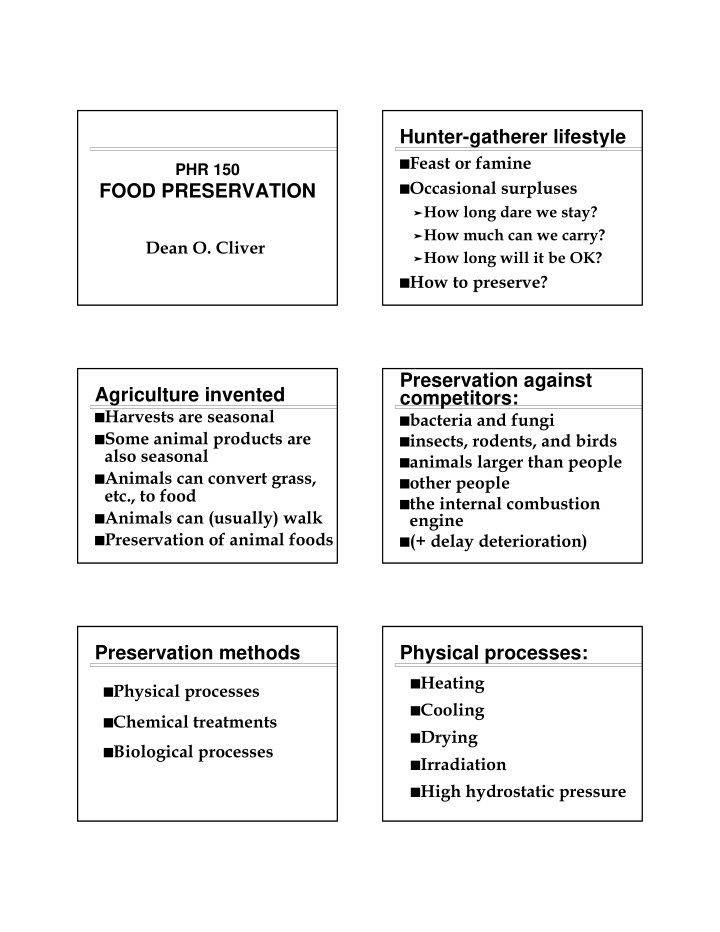



Hunter-gatherer lifestyle � Feast or famine PHR 150 � Occasional surpluses FOOD PRESERVATION � How long dare we stay? � How much can we carry? Dean O. Cliver � How long will it be OK? � How to preserve? Preservation against Agriculture invented competitors: � Harvests are seasonal � bacteria and fungi � Some animal products are � insects, rodents, and birds also seasonal � animals larger than people � Animals can convert grass, � other people etc., to food � the internal combustion � Animals can (usually) walk engine � Preservation of animal foods � (+ delay deterioration) Preservation methods Physical processes: � Heating � Physical processes � Cooling � Chemical treatments � Drying � Biological processes � Irradiation � High hydrostatic pressure
Physical — heating: Physical — heating: � Cooking: boiling water, � Heat processes, prediction direct flame, oil cooking � D value � Baking: oven vs. food temps. � z value � Below boiling: � Retorting � blanching � pasteurization Physical — cooling: Physical — drying: � (Grains often dry) � Refrigeration (mechanical): � Dehydration: evaporation retards biological processes or sublimation vs microbes, � Freezing: water in solid enzymes (examples: chuño, viande séché) state, microbial processes � Addition of solute: binds stop, some enzymatic water (examples: honey, deterioration possible salt pork) Physical — irradiation: Ionizing radiation: � Microwave: processing, � <1 kGy — sprouting control, home insects, Trichinella , � Ultraviolet: surface protozoa? treatments, disinfection of � 1 − 10 kGy — pasteurization water � >10 kGy — commercial � Ionizing radiation — sources sterilization, astronaut food 60 Co, electrons, x-rays
High hydrostatic Chemical treatments: pressure � Acidification � 600–700 MPa applied to � Enzyme treatments food � Antimicrobial additives � Kills bacteria & viruses � Processing applications still under development Chemical treatments Chemical treatments — — acidification: antimicrobial additives: � Organic acids (e.g., acetic, � Broad-spectrum: sulfites lactic, propionic): strong for wine preservation, etc. antibacterial effects � Targeted: nitrite for � Mineral acids: prevention of botulism preventing botulism; nisin —enzymes Microbiological Biological processes: processes — � Controlled, spontaneous defined inocula microbiological processes � Starter cultures: cheese (e.g., sauerkraut) vs and sausage uncontrolled � Mold inoculation: blue � Microbiological processes cheese, surface-ripened — defined inocula cheese
Summary Summary (2) � Preservation includes any � Physical processes, means to keep food safe especially drying and and fit to eat, has been heating, are probably the practiced for a very long oldest. time. � Pre-cooking, chemical preservation, HHP, and irradiation coming? Summary (3) � Controlled, defined biological processes — parts of the “art” of food science, possible safety hazards if no science base.
Recommend
More recommend